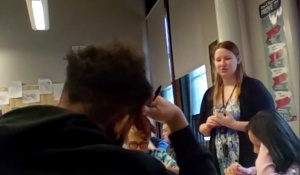
Virtual skills lead to classroom savvy
Teacher Residency alumna discovers online tools lead to leaps in class participation
BY MICHELLE KEARNS
The most memorable lesson from the pandemic about teaching for new social studies teacher Caitlin Orgek, EdM ’20, was the power of digital tools to encourage class participation—online and in-person. Their power to transform the class experience inspired her.
Caitlin Orgek teaches a class as part of her teacher certification presentation. (Video still courtesy Caitlin Orgek)
“It’s really revolutionized how I think about teaching. Seeing those kids come for our Zoom calls and having them ask questions … It definitely confirmed for me that I picked the right profession. Despite all the challenges, it worked,” Orgek said. “I really think it just gave students the confidence to answer in the way that best supported them.”
When COVID-19 closed school buildings during her residency, Orgek began experimenting with online tools to draw in students who were adjusting to the sudden shift to online learning. She was heartened to see how the video classes gave them more options to engage—by chat, class poll and anonymous response. Then, last year, when she began her first year as a full-time Buffalo Public School teacher, she kept adding web apps to her teaching practice.
She was thrilled to see her morning online group of seventh graders at Dr. Charles R. Drew Science Magnet School enthralled by a virtual field trip to see where Harriet Tubman once lived, via the interactive Nearpod web app. They took in a 360-view of the Maryland farm where Tubman was enslaved as a girl and, from there, followed her route north along the Underground Railroad.
Then, with help from Google, they gazed at the stretch of the Niagara River from the Buffalo shores where Tubman helped people escape slavery and cross by boat to safety in Canada. Orgek could tell her students felt connected to the woman who once walked the same streets that they do now. Even though her students were quiet during the virtual lessons that featured Tubman, the chat space on the class video screen filled up with their conversation.
This experience was an example of how new digital tools dovetail with and elevate class learning. With options like these, more of her students are winning all the points in the 10 percent of their grade reserved for class participation.
So far, she’s tried almost a dozen new digital apps and online interfaces. They include the Kahoot! and Quizizz platforms that make a game out of answering quiz questions. The Nearpod interactive online interface makes it easy to build video clips into lesson summaries and even lets students draw answers to questions like, ‘What does a canal look like?’ which came up during the history of the Erie Canal. She’s experimented with Schoology’s online assignment setup and the Desmos tool for animating numbers and underlining reading passages with color.
Some web apps and programs that let students respond without their names are particularly helpful. This way they avoid the risk that keep many quiet—giving a wrong answer and feeling embarrassed in front of peers. “Remaining anonymous allows that greater involvement, greater engagement,” Orgek said.
When teaching turned hybrid last spring, students could choose whether to stay home or come to class. A girl in one of her classes who was learning English as a new language was physically in class, but too shy to speak. Whenever Orgek stopped by her desk, the student would give a thumbs up as she worked on her Chromebook.
Later when Orgek looked on the Desmos platforms, she could see in real time that the girl was answering questions along with the rest of the class.
These new more flexible digital learning tools shed light on a fundamental lesson from her GSE studies: Educational experiences should be as individualized as possible. Digital tools help make that happen.
“Engagement has been shown to really advance the students’ learning,” said Orgek. “You have to have multiple ways to have students engage with the information to be able to learn. It’s our challenge as teachers to meet those needs.”
Digital Tools Library
Name | Description | Cost |
|---|---|---|
| Free or paid version available | |
| Free or paid version available | |
edmodo |
| Free or paid version available |
Name | Description | Cost |
|---|---|---|
| Free | |
| Free or paid version available | |
| Free or paid version available | |
| Free or paid version available |
Tool Name | Tool Description | Cost |
|---|---|---|
| Free | |
| Free or paid version available | |
| Free or paid version available |
Tool Name | Tool Description | Cost |
|---|---|---|
| Free or paid versions available | |
| Free or paid versions available | |
| Free or paid versions available | |
| Free or paid versions available |
Tool Name | Tool Description | Cost |
|---|---|---|
| Free or paid version available | |
| Free | |
| Free or paid version available |
Tool Name | Tool Description | Cost |
|---|---|---|
Video streaming platform Can share screen or whiteboard | Free or paid version available | |
Video-based streaming platform. Can embed Microsoft applications—Word, PowerPoint—and others Can share screen or whiteboard | Free or paid version available | |
Video-based streaming platform Can share screen or whiteboard Connects to Google apps and Classroom | Free or paid version available |
